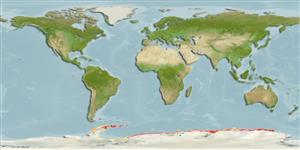>
Perciformes/Notothenioidei (Icefishes) >
Bathydraconidae (Antarctic dragonfishes) > Bathydraconinae
Etymology: Bathydraco: Greek, bathys = deep + Greek, drako = dragon (Ref. 45335).
Eponymy: James William Slesser Marr (1902–1965) was a Scottish marine biologist and polar explorer. [...] (Ref. 128868), visit book page.
More on author: Norman.
Environment: milieu / climate zone / rango de profundidad / distribution range
Ecología
marino batidemersal; rango de profundidad 300 - 1250 m. Deep-water; 60°S - 79°S
Southern Ocean: Antarctic continental shelf, South Shetland and South Orkney islands.
Tamaño / Peso / Age
Madurez: Lm ? range ? - ? cm
Max length : 23.0 cm SL macho / no sexado; (Ref. 5192); peso máximo publicado: 908.00 g (Ref. 124149)
Life cycle and mating behavior
Madurez | Reproducción | Puesta | Huevos | Fecundidad | Larva
Gon, O., 1990. Bathydraconidae. p. 364-380. In O. Gon and P.C. Heemstra (eds.) Fishes of the Southern Ocean. J.L.B. Smith Institute of Ichthyology, Grahamstown, South Africa. 462 p. (Ref. 5192)
IUCN Red List Status (Ref. 130435: Version 2025-1)
Threat to humans
Harmless
Human uses
Herramientas
Special reports
Download XML
Fuentes de Internet
Estimates based on models
Preferred temperature (Referencia
123201): -1.1 - 0.9, mean 0.1 °C (based on 397 cells).
Phylogenetic diversity index (Referencia
82804): PD
50 = 0.5313 [Uniqueness, from 0.5 = low to 2.0 = high].
Bayesian length-weight: a=0.00240 (0.00155 - 0.00371), b=2.97 (2.84 - 3.10), in cm total length, based on LWR estimates for this species & (Sub)family-body (Ref.
93245).
Nivel trófico (Referencia
69278): 3.6 ±0.4 se; based on size and trophs of closest relatives
Resiliencia (Referencia
120179): Medio, población duplicada en un tiempo mínimo de 1.4-4.4 años (Fec = 1,549-2,208).
Fishing Vulnerability (Ref.
59153): Low vulnerability (18 of 100).
🛈
